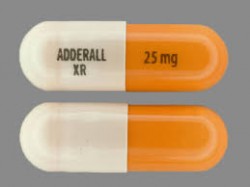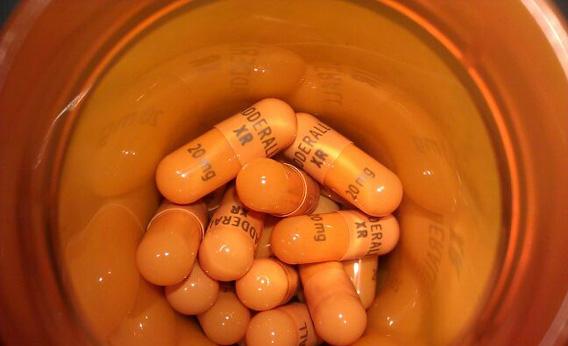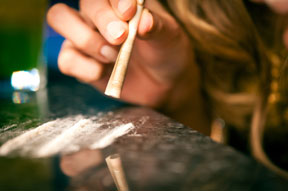Examples of Stimulants Drugs
Stimulants are a class of drugs that all cause similar effects on the body and mind. According to the NIDA, “As the name suggests, stimulants increase alertness, attention, and energy, as well as elevate blood pressure, heart rate, and respiration.” These substances can be beneficial in many ways and may be used to help individuals with learning or mental disorders become more focused and lead more productive lives. However, stimulant drugs also can be abused and certain types are only used in ways that are not medically recommended. Stimulant drugs can be used for good causes and bad causes, but generally, they all create varying degrees of the same effects.
Prescription Stimulant Drugs

Adderall is a common prescription stimulant drug.
Prescription stimulants are, for the most part, perfectly healthy to take under a doctor’s recommendation and care, although they can cause some problematic side effects even when used correctly. For these reasons (and for the fact that they do have a high potential for abuse), most prescription stimulants are labeled as Schedule II drugs under the DEA. Examples of these substances include:
- Amphetamines: “a group of synthetic psychoactive drugs called central nervous system (CNS) stimulants” (CESAR).
- Amphetamine: usually prescribed when paired with dextroamphetamine as the drug Adderall
- Dextroamphetamine: may be prescribed as Adderall with amphetamine or also alone as Dexedrine or ProCentra
- Methamphetamine: manufactured as the brand name drug Desoxyn, though not frequently prescribed by doctors because of the intense side effects it may cause
- Methylphenidate (or methylphenidylacetate hydrochloride): a stimulant found in certain brand name drugs such as:
- Ritalin
- Methylin
- Ritalin SR
- Methylin ER
- Concerta
- Quillivant XR
- Metadate CD
- Metadate ER
- Diet aids: certain types of stimulants that are prescribed as part of a full diet plan to suppress appetite and help individuals lose weight
- Benzphetamine: often prescribed under the brand names Didrex and Regimex
- Phendimetrazne: prescribed as Bontril, Bontril SR, Preludin, Melfiat, and Obezine
Several of these substances have the potential to treat individuals with life altering psychological disorders such as ADHD and narcolepsy. They cause a focusing effect that allows ADHD patients to pay better attention to whatever task is at hand. This is important because the disorder causes “more difficulty focusing, controlling actions, and remaining still or quiet than other people who are the same age” (NLM). In many ways, these substances are able to help remedy this issue, and they can also cause individuals with narcolepsy to avoid falling asleep suddenly and without warning.
Diet pills can be especially dangerous in certain cases and are only prescribed to certain individuals who need to lose weight for medical reasons.
Prescription stimulant drugs are extremely beneficial to those who need them, but they are often abused as well. This act is dangerous as it can lead to many harmful side effects such as:
- Nausea
- Headache
- Tremors
- Dangerous, unpredictable behavior
- Dry mouth
- Heart palpitations
- Breathing problems
- Mood swings
- Mood disorders
- Mental illness
- Ulcers
- Weight loss
- Malnutrition
- Coma
- Dizziness
- Stroke
- Heart attack
- Psychosis
- Addiction
These drugs are meant to be taken under a doctor’s supervision for a reason: when they are abused, they can be just as dangerous as illicit stimulants.
Illicit Stimulant Drugs
There are a number of stimulant drugs that are illegal to use recreationally and are either classified as Schedule I or Schedule II, depending on whether or not they have any medicinal uses.
- Cocaine: a “highly addictive drug of abuse” that is usually found as a white powder and often snorted through the nose (CESAR)
Cocaine is a Schedule I drug and can be abused in other ways such as by injection or ingestion. Over time, cocaine causes binge abuse, which can quickly lead to addiction.
- Crack: another form of cocaine that is found as a yellowish rock and smoked by users
The drug can cause a severe addiction syndrome very quickly, as smoking it can lead to a short but incredibly strong high that can immediately cause prolonged abuse.
- MDMA: a Schedule I synthetic substance that has properties of both stimulant drugs and hallucinogens
MDMA, also called ecstasy or molly, can cause euphoria, hallucinations, fainting, and an extremely high body temperature. This coupled with dehydration can lead to death as a result of the drug’s abuse.
- Khat: a naturally-occurring substance found in shrubs that grow in East Africa and the Arabian Peninsula
Khat’s active ingredient is cathinone which is a schedule I substance and also the same chemical found in bath salts, a type of synthetic drug (CESAR). It causes intense euphoria but also other dangerous side effects like liver damage and anorexia.
- Methamphetamine (or crystal meth): a dangerous substance that causes intense addiction and other long-term effects when abused
Because methamphetamine can sometimes be prescribed to treat ADHD, the substance itself is labeled as a Schedule II drug. However, the use of crystal meth, or the white powder form of methamphetamine, which can also be processed into a rock form for smoking, is always illegal and extremely dangerous.
- Yaba: “a tablet of methamphetamine” that is most often abused by young people who frequent raves and other types of dance clubs in Asian countries (CESAR)
As it contains methamphetamine, yaba is also a Schedule II substance, but if it is abused in large enough doses over a long period of time, it can cause all the same issues that result from long-term crystal meth abuse.
The stimulants listed above are illegal for a reason; they cause severe addiction syndromes, organ damage, malnutrition, skin diseases, and mental illness akin to schizophrenia when abused over a long enough period of time. The can also cause heart attack and stroke when taken in high doses. This is why certain stimulants are considered to be unhealthy and dangerous at any dosage and should not be taken for any reason.
These are the main examples of stimulant drugs, both licit and illicit. It is important to realize that taking too much of any stimulant can be hazardous to your health, and even if you are on a stimulant drug regimen, you should never deviate from the prescription amount given to you by your doctor and always contact them if you notice severe side effects or side effects that do not subside.



